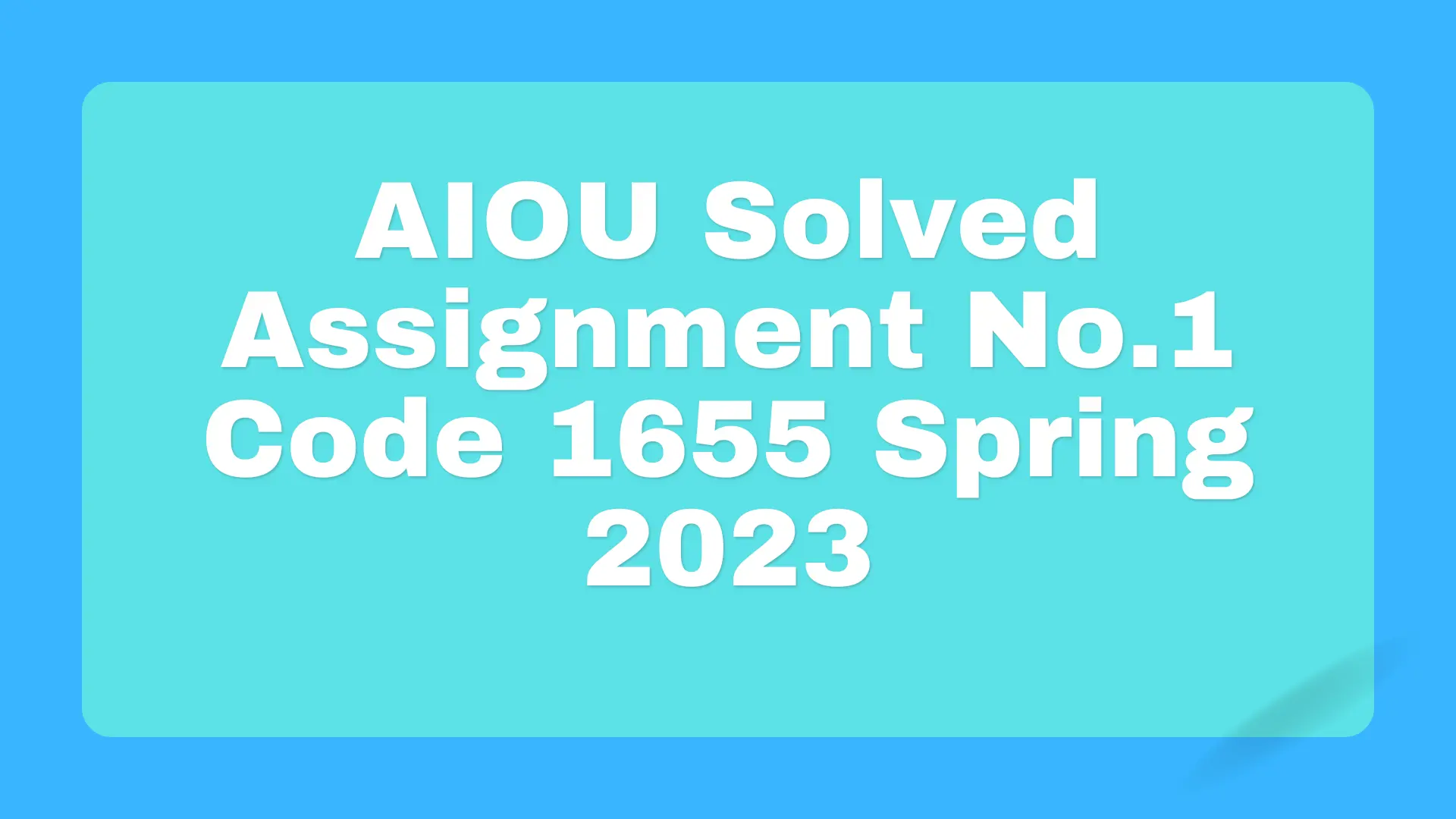AIOU Solved Assignment No.1 AIOU 1655 Spring 2024

ASSIGNMENT No. 1
(Units 1-4)
Discuss the importance of English learning as second language in Pakistan
English is widely recognized as a global language and serves as a crucial tool for communication, education, and economic growth worldwide. In Pakistan, English is considered a second language and holds significant importance due to several reasons:
- Education and Access to Knowledge: English is the medium of instruction in higher education institutions and many prestigious schools in Pakistan. Proficiency in English allows students to access a vast range of educational resources, research papers, and academic materials available in the English language. It enhances their ability to engage with global knowledge, stay updated with advancements in various fields, and pursue higher studies abroad.
- Employment and Career Opportunities: English proficiency has become a sought-after skill in the job market, particularly in multinational companies, industries, and sectors that have international dealings. Employers often require candidates to possess good English language skills for roles that involve communication, collaboration, and interaction with clients, partners, or colleagues from different countries. English fluency can significantly expand employment opportunities and enhance career growth prospects.
- International Communication: English acts as a common language for global communication. It enables individuals in Pakistan to effectively communicate with people from diverse linguistic backgrounds, both within the country and internationally. It facilitates interaction with tourists, expatriates, and foreign visitors, fostering cultural exchange, business collaborations, and diplomatic relations.
- Academic and Research Collaboration: Proficiency in English is vital for academic and research collaboration on an international scale. Pakistani scholars, researchers, and academics need English proficiency to publish their work in reputable international journals, attend conferences, present research findings, and collaborate with counterparts from other countries. English proficiency enhances their ability to engage in scholarly discourse and contribute to the global academic community.
- Personal and Intellectual Growth: Learning English as a second language broadens horizons, enhances cognitive skills, and promotes personal and intellectual growth. It exposes individuals to different cultures, literature, and ideas, expanding their worldview and fostering critical thinking abilities. English proficiency allows individuals to access a vast repository of literature, both classical and contemporary, enabling them to engage with diverse perspectives and develop a deeper understanding of the world.
- Technological Advancements: English is the dominant language in the digital sphere, including online platforms, websites, and technology-related resources. Proficiency in English enables individuals to leverage technology, access online information, utilize digital tools, and keep pace with the rapid advancements in the digital age.
Overall, English learning as a second language in Pakistan is of immense importance due to its role in education, employment, communication, academic collaboration, personal growth, and accessing global knowledge. It equips individuals with the necessary skills to participate effectively in an increasingly interconnected and globalized world.
Discuss some latest methods and strategic of teaching English as second language
Teaching English as a second language (ESL) has evolved over time, incorporating various methods and strategies to enhance language acquisition and proficiency. Here are some of the latest methods and strategies employed in teaching English as a second language:
- Communicative Language Teaching (CLT): CLT emphasizes the use of English in real-life communication contexts. It focuses on meaningful interaction, student-centered activities, and authentic language use. Students engage in tasks that require them to communicate and collaborate, fostering fluency and accuracy in English.
- Task-Based Learning (TBL): TBL involves designing activities and tasks that reflect real-world language use. Students work on specific tasks that simulate authentic language use, such as problem-solving, role-plays, or presentations. TBL promotes language acquisition through meaningful and purposeful engagement.
- Content and Language Integrated Learning (CLIL): CLIL combines language learning with the acquisition of subject-specific content. English language instruction is integrated into content-based lessons, such as teaching science, history, or mathematics in English. This approach helps students develop language skills while simultaneously learning other academic subjects.
- Blended Learning: Blended learning combines traditional classroom instruction with online and digital resources. It leverages technology to provide interactive learning experiences, including online modules, multimedia materials, virtual discussions, and language learning apps. Blended learning allows for flexibility, personalized instruction, and independent practice.
- Gamification: Gamification involves incorporating game elements and mechanics into the language learning process. It uses educational games, interactive quizzes, language learning apps, and digital platforms to engage students, motivate them, and make language learning enjoyable. Gamification can enhance motivation, retention, and active participation in language learning.
- Authentic Materials and Real-World Contexts: Using authentic materials such as newspapers, magazines, videos, podcasts, and online resources exposes students to real-world language use. It provides them with opportunities to develop their listening, reading, speaking, and writing skills in contexts they are likely to encounter outside the classroom.
- Multimodal Approaches: Multimodal approaches utilize a combination of visual, auditory, and kinesthetic elements to enhance language learning. Incorporating visual aids, multimedia resources, gestures, body language, and real-life demonstrations can help learners understand and internalize language concepts more effectively.
- Individualized and Differentiated Instruction: Recognizing the diverse needs and learning styles of students, individualized and differentiated instruction tailors teaching methods and materials to cater to learners’ specific requirements. It involves assessing learners’ language proficiency, setting personalized goals, and providing targeted instruction accordingly.
- Collaborative Learning: Collaborative learning encourages students to work together in pairs or groups to solve problems, complete tasks, and engage in language practice. It fosters peer interaction, encourages communication, and provides opportunities for language negotiation and feedback.
- Formative Assessment and Feedback: Formative assessment techniques, such as self-assessment, peer assessment, and teacher feedback, provide ongoing evaluation of students’ language skills and progress. Timely feedback helps learners identify their strengths and areas for improvement, guiding them in their language learning journey.
These methods and strategies prioritize student engagement, meaningful communication, authentic language use, and personalized instruction. They aim to create an interactive and immersive learning environment that facilitates language acquisition and proficiency development in English as a second language.
Define the role of English teacher for teaching good pronunciation at elementary level
The role of an English teacher in teaching good pronunciation at the elementary level is crucial in helping students develop accurate and understandable English speech patterns. Here are some key aspects of the English teacher’s role in teaching pronunciation:
- Modeling: The teacher serves as a model for students by demonstrating correct pronunciation of English sounds, words, and sentences. Through clear and accurate pronunciation, the teacher provides a reference point for students to emulate.
- Phonemic Awareness: The teacher introduces students to the individual sounds of the English language (phonemes) and helps develop their phonemic awareness. This includes helping students recognize and differentiate between sounds, syllables, and stress patterns in words.
- Articulation Exercises: The teacher guides students through articulation exercises that focus on the proper placement and movement of the mouth, lips, tongue, and vocal cords to produce accurate English sounds. This may involve activities such as tongue twisters, minimal pair exercises, and tongue and lip positioning drills.
- Pronunciation Drills: The teacher conducts pronunciation drills to reinforce correct pronunciation of specific sounds, words, or sentences. These drills can involve repetition, shadowing (repeating after the teacher), and imitating audio recordings to improve pronunciation accuracy and fluency.
- Intonation and Rhythm: The teacher helps students understand and practice intonation patterns, stress, and rhythm in English speech. This includes teaching the rising and falling intonation patterns in questions and statements, emphasizing stress on specific syllables, and demonstrating the natural rhythm of English sentences.
- Listening and Imitation: The teacher incorporates listening activities that expose students to authentic English pronunciation. By providing audio recordings, videos, and dialogues, the teacher encourages students to imitate and mimic native English speakers, enhancing their ability to replicate natural speech patterns.
- Feedback and Correction: The teacher provides constructive feedback and correction to students’ pronunciation errors. This can be done individually or in a group setting, focusing on specific sounds, words, or patterns that need improvement. The teacher guides students on how to correct their pronunciation by highlighting common errors and offering strategies for improvement.
- Integration into Lessons: The teacher integrates pronunciation practice into regular lessons and activities, ensuring that pronunciation is addressed alongside other language skills. For example, pronunciation can be incorporated into reading aloud, dialogue practice, role-plays, and oral presentations, allowing students to apply correct pronunciation in context.
- Engaging Activities: The teacher designs engaging and interactive activities that motivate students to practice pronunciation. This can include games, tongue twisters, pronunciation contests, and pair or group activities that encourage peer feedback and support.
- Cultivating Confidence: The teacher fosters a supportive and encouraging learning environment that allows students to feel comfortable experimenting with pronunciation. By building students’ confidence and providing positive reinforcement, the teacher helps students overcome pronunciation challenges and develop their oral communication skills.
By fulfilling these roles, the English teacher at the elementary level plays a vital role in laying the foundation for good pronunciation, helping students develop accurate and intelligible English speech, and building their overall oral communication skills.
Define meaning of word in English vocabulary learning. Also explain use of word, word formation and word grammar in teaching vocabulary
In English vocabulary learning, understanding the meaning of words is a fundamental aspect. The meaning of a word refers to its specific definition or the concept it represents. When learning new vocabulary, students aim to comprehend the meanings of words to expand their understanding and effective usage of the English language.
Here are some related concepts in teaching vocabulary:
- Use of Word: The use of a word refers to how it is applied or employed in different contexts. This includes understanding the word’s meaning in specific situations and its appropriate usage in speaking, writing, or comprehension tasks. Teaching the use of words involves providing examples, collocations, and expressions to help students grasp the proper usage and nuances of vocabulary items.
- Word Formation: Word formation involves studying the ways in which new words are created from existing words or word parts. This includes prefixes, suffixes, root words, and compound words. Understanding word formation helps students expand their vocabulary by recognizing patterns and deriving meaning from word components. Teachers can guide students to identify common prefixes and suffixes to decipher the meaning of unfamiliar words.
- Word Grammar: Word grammar refers to the grammatical patterns and structures associated with specific words. Some words have collocations or fixed expressions that follow particular grammatical patterns. Teaching word grammar involves helping students understand the word’s syntactic role, its relationship with other words in sentences, and how it influences sentence structure. For example, teaching the use of prepositions with certain verbs or adjectives.
In teaching vocabulary, educators employ various strategies to support students’ learning. These strategies include:
- Contextual Clues: Encouraging students to use the context of a sentence or text to infer the meaning of unfamiliar words.
- Dictionary Use: Guiding students on effective dictionary usage to look up definitions, examples, and related words for deeper understanding.
- Word Mapping: Creating visual word maps or semantic networks to connect new words with their meanings, synonyms, antonyms, and related concepts.
- Contextualization: Providing meaningful contexts, such as reading passages, authentic materials, or real-life situations, to reinforce vocabulary acquisition and application.
- Repetition and Practice: Incorporating vocabulary exercises, games, and activities that allow students to practice using newly learned words in different contexts.
- Word Lists and Flashcards: Introducing thematic word lists and utilizing flashcards for memorization and review of vocabulary items.
By integrating these approaches, teachers can facilitate vocabulary learning and help students develop a rich and functional English vocabulary, enabling them to express themselves accurately and comprehensively in both spoken and written communication.
You May also read…

My brother suggested I might like this blog He was totally right This post actually made my day You can not imagine simply how much time I had spent for this info Thanks